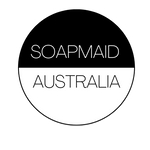
The Art of Natural Soapmaking: Understanding SAP Values
SAP Values in Soapmaking: The Science of Perfect Lye Calculation
Master lye, superfat, and oil balance — avoid harsh or greasy soap with this Australian guide

Natural soapmaking is art + science. While creativity shapes scent and design, chemistry ensures safety and performance. At the heart of this science is the Saponification (SAP) value — the exact amount of lye needed to turn oils into soap. This Australian soapmaker’s guide explains SAP, lye calculation, superfatting, and safety — with formulas, examples, and a full oil chart.
What is Saponification?
Fats/oils + alkali (NaOH) → soap + glycerine. This exothermic reaction is the foundation of all true soap.
Understanding SAP Values
SAP = milligrams of KOH to saponify 1 g of oil. For solid soap, we use NaOH and convert using:
NaOH = KOH SAP × 0.713
Why SAP Values Matter
- Safety: Too much lye → harsh, caustic soap
- Performance: Too little lye → oily, soft, rancid bar
- Consistency: Accurate SAP = repeatable results
- Customisation: Balance hardness, lather, conditioning
Rule of Thumb: Always superfat 5–8% for skin-safe, moisturising soap.
How to Calculate Lye Using SAP
Step-by-Step Formula
- Weigh each oil in grams
- Multiply by NaOH SAP value
- Sum all oils
- Apply superfat discount
Lye = Σ (Oil Weight × NaOH SAP) × (1 – Superfat %)
Example: 700 g Oil Batch (5% Superfat)
| Oil | Weight (g) | NaOH SAP | Lye (g) |
|---|---|---|---|
| Olive Oil | 500 | 0.135 | 67.5 |
| Coconut Oil | 200 | 0.190 | 38.0 |
| Total | 700 | 105.5 | |
| 5% Superfat | 100.2 g NaOH | ||

Common Oil SAP Values (NaOH)
| Oil | NaOH SAP | Properties in Soap |
|---|---|---|
| Olive Oil | 0.135 | Conditioning, gentle |
| Coconut Oil | 0.190 | Hard bar, big bubbles |
| Palm Oil | 0.142 | Hard, stable |
| Castor Oil | 0.128 | Creamy lather |
| Shea Butter | 0.128 | Moisturising |
| Sweet Almond | 0.136 | Mild, conditioning |
Superfatting & Lye Discounts
Superfat = unsaponified oils left for moisturising.
- 0%: Full cleansing, can be harsh
- 5–8%: Standard for face/body
- 10–15%: Sensitive/dry skin
- 20%: Castile-style
Lye Safety:
• Wear gloves, goggles, long sleeves
• Work in ventilated area
• Add lye to water (never water to lye)
• Keep vinegar nearby for neutralisation
• Wear gloves, goggles, long sleeves
• Work in ventilated area
• Add lye to water (never water to lye)
• Keep vinegar nearby for neutralisation
Pro Tip: Use a lye calculator (SoapCalc, Soapmaking Friend) to double-check every batch.
